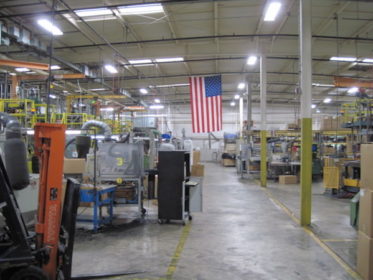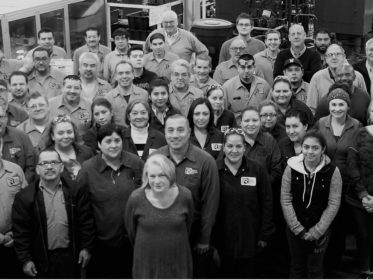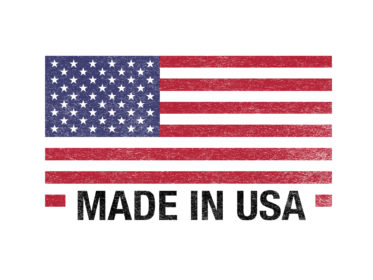
We discovered MachineMetrics at EASTEC 2019 when we picked up one of their case studies, which, at first glance, we thought was a four-page brochure.
Printed on luxe matte paper, and featuring short copy and icons, the printed piece immediately caught our eye.
After talking to Graham Immerman, the company’s VP of Marketing, we realized manufacturers of any size could learn from the company’s branding journey.
“The main challenge the MachineMetrics platform solves is the lack of insight,” says Immerman. “Many manufacturers don’t understand what’s happening on the shop floor with regard to their machines. With our platform, they can analyze the data from a dozen machines in one factory to thousands across multiple facilities.”
The platform gives manufacturers real-time data about plant and machine productivity, including how to improve it or how machine problems or maintenance events affect it.
Having this data allows manufacturers to make better decisions, improve machine utilization, and increase billings (to name a few things).
Simplifying a complex story
Since manufacturing is a notoriously slow industry to adopt new technology, the company’s greatest hurdle had been both communicating what the platform was and how it could help customers, but also why their product was no longer a “nice to have” but a “must-have” for all manufacturers.
“I come from a Madison Avenue, consumer advertising background,” says Immerman. “When I met Bill (Bither), the co-founder of MachineMetrics, I realized a huge opportunity existed to break ground using some of the tactics I had used with big consumer brands such as Starbucks and Reebok.”
The first problem that needed solving was revising the existing messaging, which was incredibly dense and difficult to understand.
The team reworked everything from scratch, including fonts, colors, and the words used to describe the platform. Immerman’s team also paid close attention to the quality of all marketing elements. He wanted the entire brand experience to reflect that the company was delivering a premium product.
Leveraging the company’s new messaging, Immerman implemented an integrated marketing strategy focused on delivering the right information to the right people at the right time.
Through educational campaigns, targeted advertising, and digital content marketing, the company experienced a dramatic uptick in both web traffic, inbound leads, and marketing generated revenue.
A different type of case study
Case studies typically follow a standard format. Usually written in long-form, case studies tell a story using a “challenge, solution, results” outline.
“We knew from talking with prospects,” says Immerman, “that they wanted to cut to the chase: what’s the ROI of the MachineMetrics platform?”
Based on this insight, the marketing team asked, “What’s the minimum amount of information needed to tell the story?”
One of their early test pieces was the case study handed out at EASTEC.

Same format, fewer words
According to Immerman, the team wanted to see how quickly they could drive value using icons and numbers versus lots of copy. The team was also testing iconography for use through other marketing elements.
The cover headline boldly declares the result: “Carolina Precision Manufacturing increased capacity by $1.5 million in year one with the MachineMetrics platform.” To drive home the point, the $1.5 million stands out in green.
The inside spread catches the eye and turns the traditional case study on its head with lots of bold subheads, icons, and very brief copy.
We like how the “Solution” section is boiled down to two sentences: “Real-time Dashboards installed on TVs across the shop floor to monitor machine performance,” and “Operator touch screens installed at every machine for downtime and quality tracking.”
The story in numbers
While the icons and short copy were good, clearly defined metrics is what the platform is all about.
Hence, the back page, which shows six metrics, in a large bold font, important to CNC manufacturers.
“The numbers are what everyone wants to know,” says Immerman. “So all a salesperson has to do is flip the case study over to the back page, and there they are.”
Advice for manufacturers
Before beginning any branding work, Immerman advises that you first map out your buyers’ journey. The marketing team uses other content to educate
prospects.
“We don’t give people a case study if they don’t know what machine monitoring is,” he says. The team has created content that explains the different types of machine monitoring, how to implement it, and why MachineMetrics is the best machine monitoring platform for specific applications.
He also advises testing things and always measuring results. “The Carolina Precision case study was a test. We also have had long-form case studies. We test things, analyze data, and listen to feedback from customers and sales.
“Think of each marketing element as a tool that allows your sales team to speak to customers while providing the right information when they need it.”
Based in Northampton, MA, MachineMetrics IIoT Platform enables manufacturers to improve productivity, increase capacity, and drive other decisions using machine data. Learn more by visiting machinemetrics.com.




